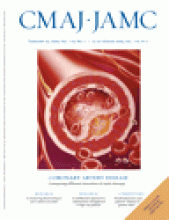- © 2008 Canadian Medical Association
Abstract
Background: In addition to nonmodifiable genetic risk factors, potentially modifiable factors such as hypertension, hyperlipidemia and environmental exposures have been identified as risk factors for Alzheimer disease. In this article, we provide physicians with practical guidance on risk assessment and primary prevention of Alzheimer disease based on recommendations from the Third Canadian Consensus Conference on the Diagnosis and Treatment of Dementia, held in March 2006.
Methods: We developed evidence-based guidelines using systematic literature searches, with specific criteria for study selection and quality assessment, and a clear and transparent decision-making process. We selected studies published from January 1996 to December 2005 that met the following criteria: dementia (all-cause, Alzheimer disease or vascular dementia) as the outcome; longitudinal cohort study; study population broadly reflective of Canadian demographics; and genetic risk factors and general risk factors (e.g., hypertension, education, occupation and chemical exposure) identified. We graded the strength of evidence using the criteria of the Canadian Task Force on Preventive Health Care.
Results: Of 3424 articles on potentially modifiable risk factors for dementia, 1719 met our inclusion criteria; 60 were deemed to be of good or fair quality. Of 1721 articles on genetic risk factors, 62 that met our inclusion criteria were deemed to be of good or fair quality. On the basis of evidence from these articles, we made recommendations for the risk assessment and primary prevention of Alzheimer disease. For the primary prevention of Alzheimer's disease, there is good evidence for controlling vascular risk factors, especially hypertension (grade A), and weak or insufficient evidence for manipulation of lifestyle factors and prescribing of medications (grade C). There is good evidence to avoid estrogens and high-dose (> 400 IU/d) of vitamin E for this purpose (grade E). Genetic counselling and testing may be offered to at-risk individuals with an apparent autosomal dominant inheritance (grade B). Screening for the apolipoprotein E genotype in asymptomatic individuals in the general population is not recommended (grade E).
Interpretation: Despite the personal and societal burden of dementia, our understanding of genetic predisposition to dementias and the contribution of other risk factors remains limited. More importantly, there are few data to explain the overall risks and benefits of prevention strategies or their impact of risk modification.











